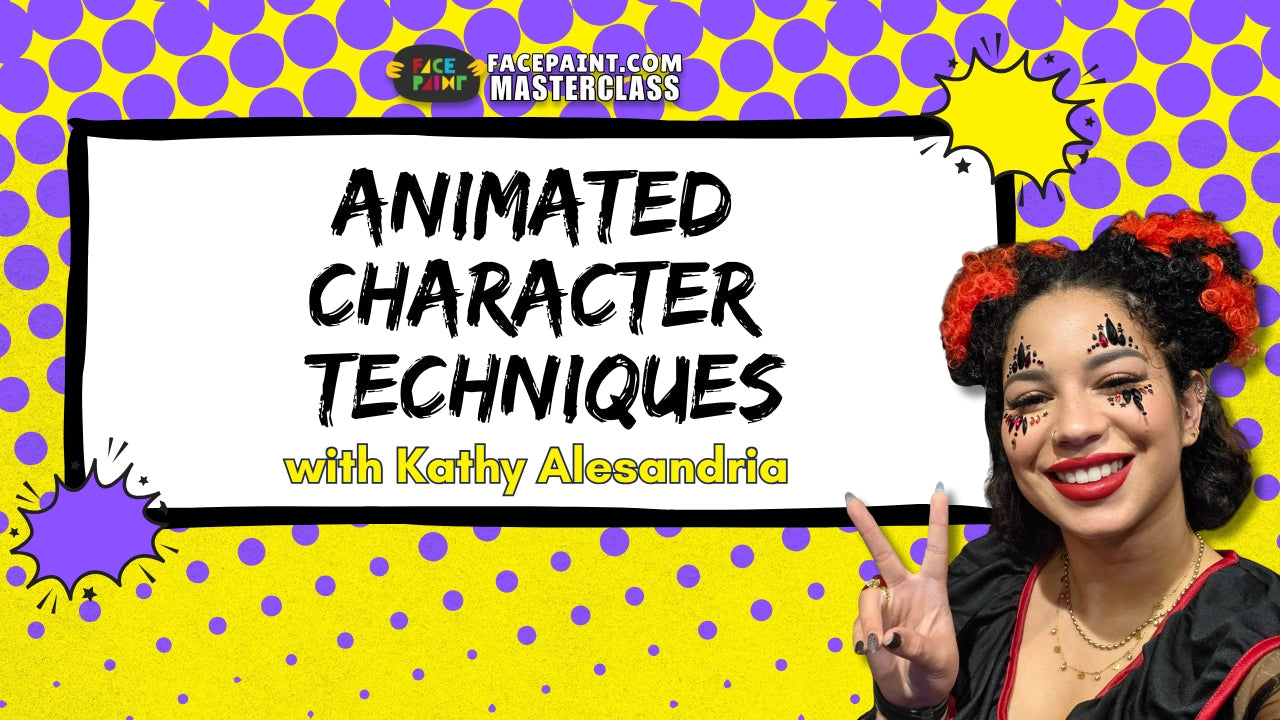
Tigers are one of our most popular requests as face painters and are loved by both boys and girls! However, most “Fantasy Tiger” designs tend to be more feminine, so I wanted to design one that was bold and a bit more masculine. This fiery tribal tiger is fun to paint and the contrast of the black detailing against the bright orange makes it really pop! Feel free to play with this design and make it your own by using different line work, swirls and tribals.
Supplies suggested for this design:
Rainbow Cake (Red, Orange, Yellow)
Always Wicked Art Butterfly Sponge
Paradise Fine Round Brush #813
Silly Farm Paint Pal Little Drop Filbert Brush
Step one: white base
I like to use an “Always Wicked Art Butterfly Sponge” for muzzles, a trick I learned from Cameron Garrett. It already has the shape of the muzzle so it works great. Start by getting the outside edges where you want them and fill it in.
It always is a good idea to research your subject matter. Google “Tiger” and you will find helpful images of actual tigers. I found that tigers have a broad muzzle and nose, so keep your muzzle on the broader side.
Continue, using the same sponge above the eyes and into the ears. The tip of the butterfly sponge works good to get into the corner of the eye. Then squeeze the wide end of the sponge a little to paint the ear shapes, being careful to keep them on the smaller side. Tigers have small ears in relation to their face. I use a small filbert brush to paint white under the eyes. It is a good idea to have them “look up with their eyes” while you paint that area. Give them a couple breaks while you do it so they don’t tear up.

Step two: colored base
Using a split cake that is red, orange and yellow, apply the colored base with a sponge. I use a Butterfly Sponge for this area also. The shape of it works great to fill in the cheek area and the forehead. Be sure to load it with the darker colors on the wide end and the yellow on the pointed end. Apply some color inside the ears with the same sponge. I apply color to the nose area at the end of this process because the sponge doesn’t have as much paint on it and it makes for a softer transition. You can blend it together using your white sponge if needed.
Don’t worry about getting the base edges perfect as you will be painting the black line work over it which will hide any rough edges.

Step three: nose, chin, fangs
To give an interesting twist, I used a flame stencil for the chin. I used the same sponge I had used for the orange base and just put a little black on the wide edge of it. With orange, paint the nose, bringing it down towards the lip in an inverted triangle. Paint the fangs on either side of the fiery chin.

Step four: black line work begins
Now for the black detailing...my favorite part! I used Wolfe black and a round brush. Use whatever round brush you prefer. I usually use a #3 or smaller for these kind of details. Start by applying the foundational lines that will separate your design into sections, always making sure they are going towards the center focal point between the eyes. All the line work in this design will be rounded and curved. Notice the outer black line is a continuous line that starts at the muzzle and extends up and around the ears and finishes with the swirl in the center of the ear.

Step five: outline eye area
Outline the eyes above and below. This step is optional depending on the age of your subject. Extend a line from the outer corner of the eye up towards the eyebrow and then swoop it down in a point towards the focal point and paint in the triangular shape so that the curve is parallel with the inner stripe.

Step six: muzzle and nose details, outline flames and fangs
I wanted to give the muzzle a unique look using fun curvy line work. Start with the bottom traditional line that points downward, then for the next one, start it in the same way, but then round it off and curve it up towards the center focal point. I outlined the chin flames, but you may leave it as is if desired as it takes extra time to do it. Outline the nose edges carefully. I start on the rounded corners and bring the line in towards the center leaving it open in the middle. Then bring a thin line up from each side, again pointing towards the focal point. For the fangs, you may outline the whole tooth or just one side.

Step seven: cheeks
There is one large shape on the cheek area...sort of like an “anvil” shape. Create the outer shape and fill it in with black. Note how the points continue to point towards the focal point.
Note: I rounded off the outer edges of the white sections of the muzzle between the black line work. (Compare it to the above photo.)

Step eight: forehead and chin detailing
Complete the design with the forehead line work. I used a series of swirly curvy lines in sections. Tiger markings typically follow a center line down the forehead and are a mirrored image from the right side to the left side. Finish it off with dots down the center going from large to small which helps to fill in the empty area in the center. I also added an sideways “C” shape on the lower lip and filled it in with white for additional interest.

Focal point
I have created an “X” over the design to demonstrate the Basic Focal Point of this design from beginning to end.

This is a GRRRRRRREat design to give that WOW factor at any event! A big thank you to my beautiful model, Mikayla!
Pam Kinneberg is the owner and artist for her business, PiKadilly Face Painting located near Fargo, North Dakota. She has won numerous contests and can be found in various magazines including SkinMarkz Magazine, The Colored Palette, QMagazing, Wet Paint Magazine and SillyFarm Newsletters.
Facebook: http://www.facebook.com/Pikadillyfacepainting
Instagram: @pikadillyfacepainting
Website: http://www.pikadillyfacepainting.com
 FREE SHIPPING FOR USA ORDERS OVER $100
FREE SHIPPING FOR USA ORDERS OVER $100








Michelle Richards
February 11, 2018
Fantastic artwork & great detailed instructions. I will try this! Thank you for sharing your wonderful work.